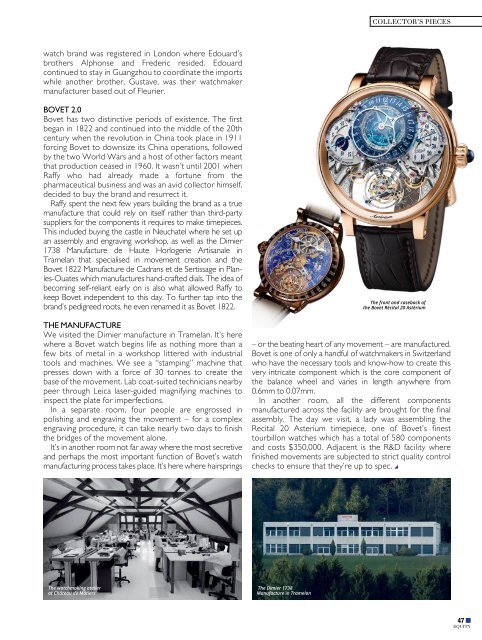Equity Mag Jan_18 Book Folder
Create successful ePaper yourself
Turn your PDF publications into a flip-book with our unique Google optimized e-Paper software.
COLLECTOR'S PIECES<br />
watch brand was registered in London where Edouard’s<br />
brothers Alphonse and Frederic resided. Edouard<br />
continued to stay in Guangzhou to coordinate the imports<br />
while another brother, Gustave, was their watchmaker<br />
manufacturer based out of Fleurier.<br />
BOVET 2.0<br />
Bovet has two distinctive periods of existence. The first<br />
began in <strong>18</strong>22 and continued into the middle of the 20th<br />
century when the revolution in China took place in 1911<br />
forcing Bovet to downsize its China operations, followed<br />
by the two World Wars and a host of other factors meant<br />
that production ceased in 1960. It wasn’t until 2001 when<br />
Raffy who had already made a fortune from the<br />
pharmaceutical business and was an avid collector himself,<br />
decided to buy the brand and resurrect it.<br />
Raffy spent the next few years building the brand as a true<br />
manufacture that could rely on itself rather than third-party<br />
suppliers for the components it requires to make timepieces.<br />
This included buying the castle in Neuchatel where he set up<br />
an assembly and engraving workshop, as well as the Dimier<br />
1738 Manufacture de Haute Horlogerie Artisanale in<br />
Tramelan that specialised in movement creation and the<br />
Bovet <strong>18</strong>22 Manufacture de Cadrans et de Sertissage in Planles-Ouates<br />
which manufactures hand-crafted dials. The idea of<br />
becoming self-reliant early on is also what allowed Raffy to<br />
keep Bovet independent to this day. To further tap into the<br />
brand’s pedigreed roots, he even renamed it as Bovet <strong>18</strong>22.<br />
THE MANUFACTURE<br />
We visited the Dimier manufacture in Tramelan. It’s here<br />
where a Bovet watch begins life as nothing more than a<br />
few bits of metal in a workshop littered with industrial<br />
tools and machines. We see a “stamping” machine that<br />
presses down with a force of 30 tonnes to create the<br />
base of the movement. Lab coat-suited technicians nearby<br />
peer through Leica laser-guided magnifying machines to<br />
inspect the plate for imperfections.<br />
In a separate room, four people are engrossed in<br />
polishing and engraving the movement – for a complex<br />
engraving procedure, it can take nearly two days to finish<br />
the bridges of the movement alone.<br />
It’s in another room not far away where the most secretive<br />
and perhaps the most important function of Bovet’s watch<br />
manufacturing process takes place. It’s here where hairsprings<br />
The front and caseback of<br />
the Bovet Récital 20 Astérium<br />
– or the beating heart of any movement – are manufactured.<br />
Bovet is one of only a handful of watchmakers in Switzerland<br />
who have the necessary tools and know-how to create this<br />
very intricate component which is the core component of<br />
the balance wheel and varies in length anywhere from<br />
0.6mm to 0.07mm.<br />
In another room, all the different components<br />
manufactured across the facility are brought for the final<br />
assembly. The day we visit, a lady was assembling the<br />
Recital 20 Asterium timepiece, one of Bovet’s finest<br />
tourbillon watches which has a total of 580 components<br />
and costs $350,000. Adjacent is the R&D facility where<br />
finished movements are subjected to strict quality control<br />
checks to ensure that they’re up to spec.<br />
The watchmaking atelier<br />
at Château de Môtiers<br />
The Dimier 1738<br />
Manufacture in Tramelan<br />
47<br />
EQUITY
















